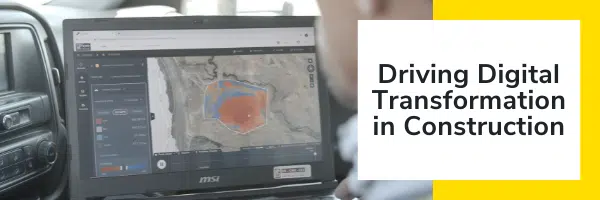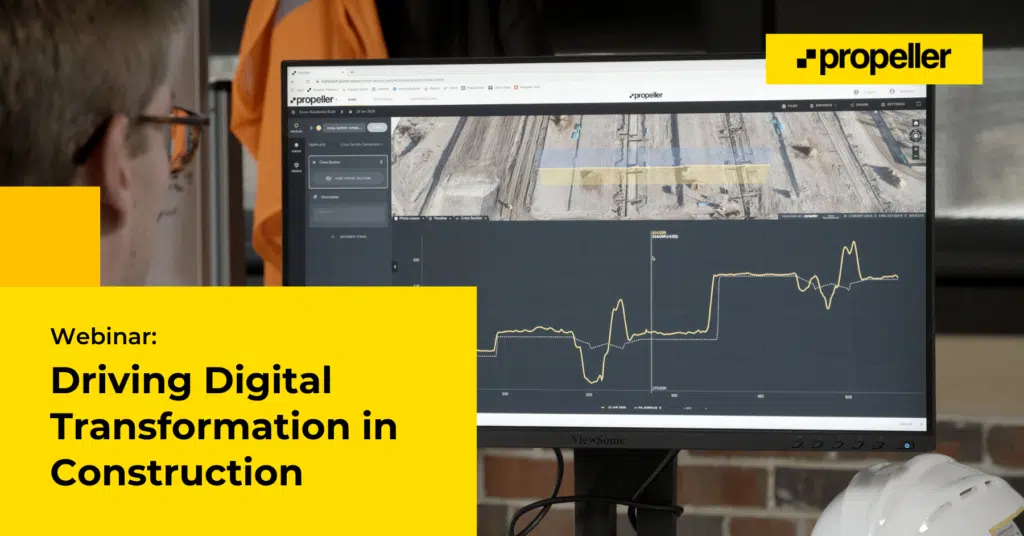Driving Digital Transformation in Construction with John Rygg, Kiewit and Mike Scott, Propeller Aero
The term “digital transformation” has made its way into the mainstream as many industries embark on the journey toward digitizing and automating digital processes. But digital transformation isn’t just for tech companies or manufacturing giants, it’s a reality for construction and earthworks companies, too.
In fact, the past decade has been filled with tech advancements that have not only improved processes and efficiencies in the office and in the field, but also significantly improved accuracy, communication, and more. Kiewit Technology Strategist John Rygg joined Propeller Aero U.S. Sales Manager Mike Scott for an engaging conversation about where we’ve been with construction tech and where we’re likely going as an industry during “Driving Digital Transformation in Construction [Webinar].”

During this webinar, Rygg and Scott discuss:
- Real-world strategies for identifying and driving innovative opportunities for Kiewit
- Most influential technological advancements that have streamlined operations for construction in the past decade
- Top consideration when evaluating new tech
- The role cell phones, augmented reality, and other technologies play in the field
Here’s a peek into the conversation. [Note: You can watch the full 60-minute webinar here.]
Which area of construction do you think has advanced the most over the past decade?
Accuracy and communication are two key areas that have changed the most in the past decade, commented Rygg. For example, BIM (Building Information Modeling) and modeling itself has changed quite a bit. If you go back 10 years, you didn’t see a lot of construction companies across the industry using modeling much. Now that more tools are available to generate highly accurate models—from photogrammetry to LIDAR—you see a lot more people using these tools in virtually every area of construction. In the past, just the vertical and the building side of things used modeling, but now it’s penetrated every aspect of the industry. These tools really aid in better communication and project accuracy as they enable you to communicate what you’re building with a 3D model, which really helps you understand what you’re making.
What’s driving construction companies to look more closely at technology?
Construction has always been lagging when it comes to digitization. From a purely innovation perspective, the construction industry has been innovating for years. In the past, we innovated with mechanical things (e.g., better equipment, better ways of doing construction work) and we’ve done a good job at that. But what we didn’t focus as much on is the digital technology side of things because it wasn’t available to us.
We’ve gotten to the point now where technology has caught up to the industry, and companies are focusing on optimizing their business and making themselves more profitable through the use of technology, Rygg highlighted.
What advice would you give someone evaluating construction tech today?
There’s a lot of technology solutions on the market today. At Kiewit, we track about 500 different types of technology every day. I’m dedicated to that, but smaller companies likely won’t have that as a resource. I recommend going to construction conferences that focus on technology as a great way to understand the “low hanging fruit” that you can focus on to see immediate gains.
Drone technology is a great example of that low hanging fruit. We’ve been using them for 5-6 years now at Kiewit. When we first started using drones, they were just consumer devices. They were toys. Now, they are tools on our job site just like a hammer, Rygg shared.
What have you used as a benchmark for success when adopting a new technology?
Adoption on a job site is a really good benchmark. The willingness to use it. The understanding of the technology. We always try to get an ROI (return on investment) with the technology. With high adoption, we can typically see the ROI right away. For example, if I send a piece of technology out and the team on the job site won’t give it back to me, I know that’s something that’s pretty useful for them.
How can companies effectively introduce technology on the job site?
When we introduce technology, we typically look for people who are leaning forward into technology and have an interest in it. They tend to be a little more forgiving when it comes to technology because they have an interest in it to begin with, and they understand that technology doesn’t always work the first time.
I think anyone introducing technology to a job site should do it with a proof of concept. Fail fast. Don’t put the job site through a long process of the technology not working. Do a two-week sprint. Understand how the technology is working for the team. Be there on the job site to answer questions. Make sure the vendor is engaged. It really makes a big difference if you put the effort in during that proof-of-concept period and then pivot, if needed.
Continue this conversation, on-demand
This isn’t the end of the conversation. Rygg and Scott continue to discuss the current climate for construction tech, real-world advice, and examples that can help construction companies of all sizes assess, adopt, and evaluate construction tech for their business, and what the future holds for construction companies. Don’t miss all of the juicy details—check out the on-demand recording of “Driving Digital Transformation in Construction.”





